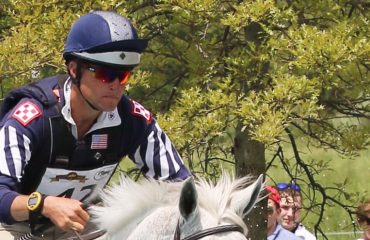 Richard Wheeler, DVM, was born in the U.K. and graduated from the Royal Veterinary College, London, in 2002. Dr. Wheeler then completed a two-year internship at Greenwood, Ellis and Partners (now Newmarket Equine Hospital) in Newmarket. In 2005, he moved to Wellington, Florida, to join Palm Beach Equine Clinic and he became a partner in 2009. Dr. Wheeler’s primary concentration is equine sports medicine. He is an FEI Veterinary Delegate for show jumping and dressage and has authored several published articles on the topic of equine sports medicine. Dr. Wheeler has served on the board of the USHJA Horse and Rider Advocates Committee. In 2016, Dr. Wheeler became a founding director of the Sport Horse Research Foundation. Dr. Wheeler and his wife, Jessica, have two children. Do you have a question you want Dr. Wheeler to answer? Send questions to editor@sidelinesnews.com.
Richard Wheeler, DVM, was born in the U.K. and graduated from the Royal Veterinary College, London, in 2002. Dr. Wheeler then completed a two-year internship at Greenwood, Ellis and Partners (now Newmarket Equine Hospital) in Newmarket. In 2005, he moved to Wellington, Florida, to join Palm Beach Equine Clinic and he became a partner in 2009. Dr. Wheeler’s primary concentration is equine sports medicine. He is an FEI Veterinary Delegate for show jumping and dressage and has authored several published articles on the topic of equine sports medicine. Dr. Wheeler has served on the board of the USHJA Horse and Rider Advocates Committee. In 2016, Dr. Wheeler became a founding director of the Sport Horse Research Foundation. Dr. Wheeler and his wife, Jessica, have two children. Do you have a question you want Dr. Wheeler to answer? Send questions to editor@sidelinesnews.com.
My 9-year-old warmblood showjumper feels weak; I’m finding it hard to maintain muscle and I don’t feel enough push over fences. He isn’t lame, but I feel like there is something wrong. Do you have any ideas?
This isn’t an uncommon complaint. There are a several possible medical and training issues that can be investigated. When presented with such a case, I would start with a full performance evaluation where we would look for subtle lameness issues as well as evaluating the cardiovascular, gastrointestinal, neurologic and respiratory systems.
We would discuss the performance issue with rider, trainer and groom to ascertain if the issue is consistent or periodic. We would then ask questions to determine if the horse feels the same all the time or if he deteriorates during the course; if he’s different depending on environmental conditions; and if there have been other clinical signs such as coughing, shifting in one direction or reluctance to eat.
While evaluating the horse on a leadline, flexion tests and observing the horse under saddle, we look for subtle lameness and/or positive flexion test results that may indicate underlying pain that may only manifest when under stress such as performing in the ring.
Simple blood and fecal tests can be used to look for muscle and gastrointestinal issues, and, if indicated, further tests such as gastroscopy, muscle biopsy and endoscopy of the airways can be used to further investigate the problem.
Recently, together with Dr. Heidman, our internal medicine specialist, we’ve been able to identify subtle problems in horses performing well but not to their full potential. In some cases, samples taken from the lungs have identified lower airway inflammation that was easily helped with medication and allowed the horse to perform successfully at the highest level. In other cases, a muscle biopsy was performed and identified underlying muscle disease and/or problems with trace minerals, which was easily helped with dietary changes and oral supplements.
While the issue you are experiencing may not be severe, these tests are minimally invasive, the treatments are often simple and investigating may be valuable in optimizing the performance of your horse.
I saw an article noting that a British survey discovered that many horse owners try therapies for musculoskeletal injuries without talking to their veterinarians first. What are some of the dangers to such therapies?
This is an issue that’s been present throughout my career, both as a veterinarian and as a horseman. Since I was young, there have always been therapies touted as the next best thing for optimizing equine performance and helping the equine athlete heal. Some therapies have stood the test of time, while many have fallen out of favor.
As veterinarians, we try to practice evidence-based medicine, relying on scientific research to guide our clients with regard to the best diagnostic treatment and therapy options for their equine athletes. This limits our confidence to therapies that have been well-researched and proven to be both safe and useful. Given the constraints of time and finances, it’s difficult for new and novel therapies to achieve this level of scrutiny. However, without such investigation, we’re guessing as to whether such techniques are really achieving what we expect. In many cases, products are brought to the market before we have genuine evidence that they’re valuable. I’ve seen many instances where a client has spent a lot of time and money on therapies without an accurate diagnosis only to find, once the real problem was identified, that such techniques were a waste.
I’m privileged in my current role, given the fact that I’m in close contact with my clients, generally on a daily or weekly basis, and I have a close working relationship with other professionals providing farriery and alternative therapies. I’m often asked what I think about new therapies and whether or not they are worth trying. My primary concern is to establish an accurate diagnosis of the problem at hand. Once this has been determined, then it’s time to discuss treatment options.
While I’m generally not an advocate for unproven and under-investigated therapies, there are occasions where clients want to try something new and potentially useful. The discussion then comes down to potential harm: There are many therapy options that, while unproven, have been shown to be safe, and in that case the only risk is a financial one.
I hope that horse owners will begin to see the value of unbiased scientific research both for the health and well-being of their horses. With more clients asking for good research behind the products offered to them, companies will be incentivized to investigate their products prior to market, which is something I believe we’ll all benefit from.
What was the most easily preventable injury you saw recently? What could have been done differently?
As with any sport, injuries are inevitable. I’m happy to say that in the sports I’m directly connected with, severe injuries are rare. I believe the majority of horses are exceptionally well cared for and injury prevention is at the front of everyone’s mind. However, any injury — even that considered mild — is devastating to the owners and trainers of our equine athletes. Following a diagnosis, we all look to see what could have been done differently.
I can’t say that this season I’ve seen an injury that could have been easily prevented. For me, the factors are adequate fitness and training, good farriery and regular examinations for performance (to identify mild problems before they become significant). This is a team sport and it requires a team approach. The best riders, trainers, grooms, farriers and veterinarians work together and share information on a regular basis to identify problems before they become a big problem. I would say that I’ve seen several instances recently where a sharp-eyed groom noticed some minor swelling and a sensible trainer had us check the horse immediately, preventing an injury from worsening and becoming more significant.
The best horsemen I’ve worked with share a particular trait: attention to detail. I’m always impressed with the groom who calls or finds me first thing in the morning concerned about subtle changes in a horse’s routine or leg palpation. I’ve learned never to ignore these insights because they know the horses better than anyone, and often their concerns are well founded.
Going to another level, I have some clients who will perform routine, periodic advanced imaging on their top horses. Nuclear scintigraphy, or bone scans, would be the most logical and frequently used modality. I’ve found, during the competition seasons, that it’s helpful to refer back to such exams, both to guide therapy programs and also to know when we need to back off and give the horse time to rest.












